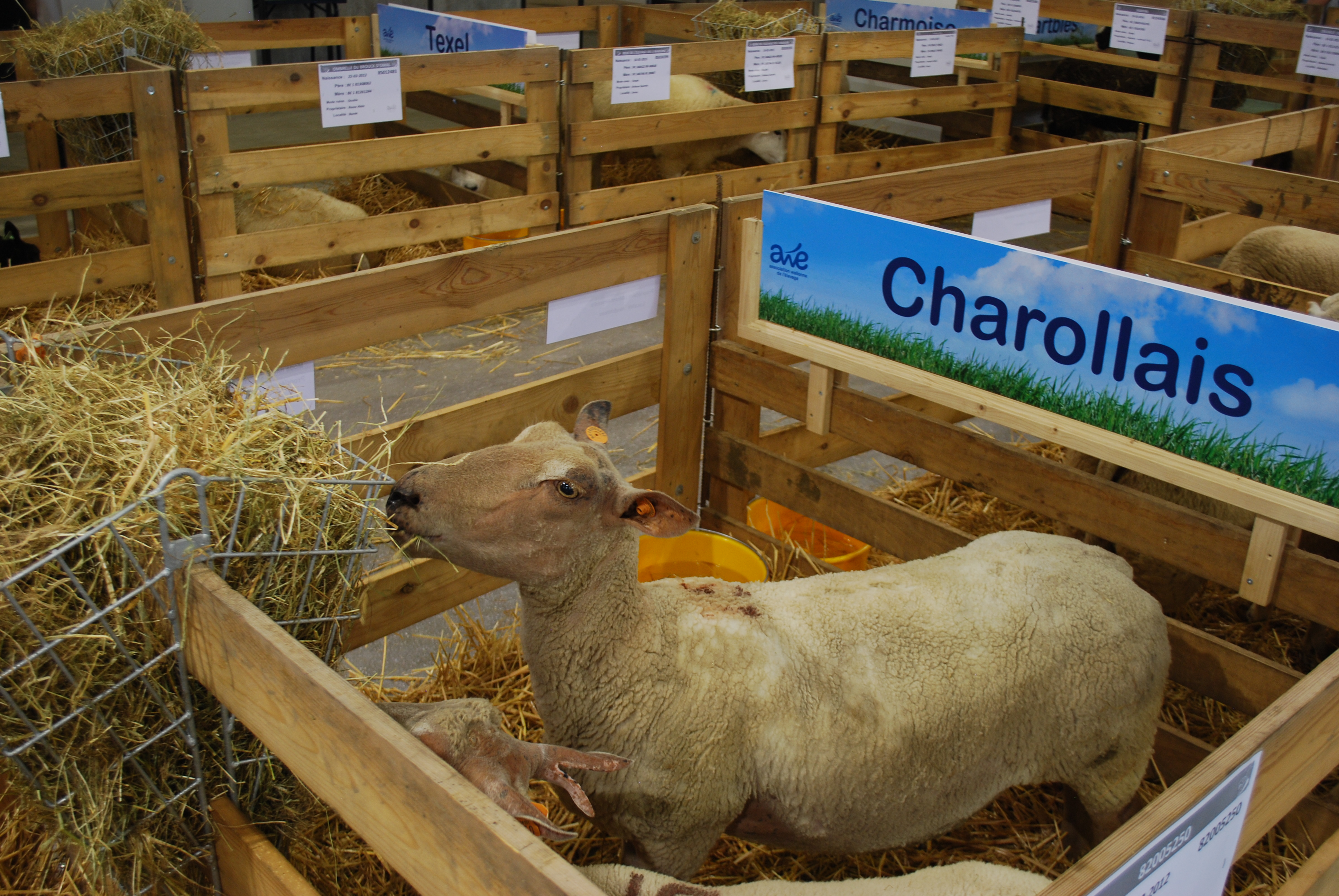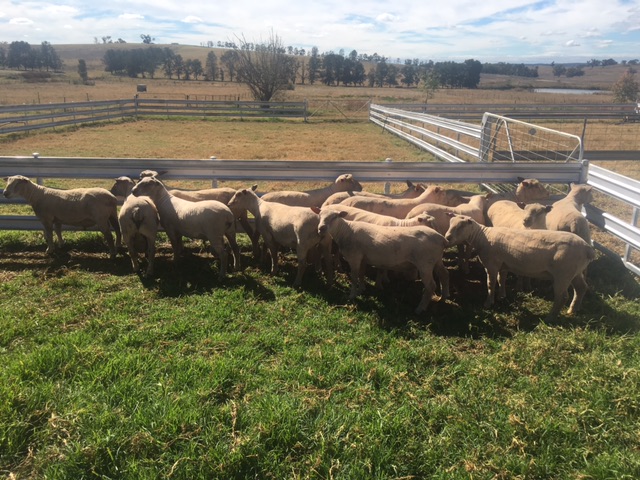Charollais (sheep) on:
[Wikipedia]
[Google]
[Amazon]


 The Charollais is a breed of domestic sheep originating in east central France, in the same region in which Charollais cattle, Charolais cattle originated, Charolles and Saône-et-Loire. It is known for ease of lambing and is used as a terminal sire to increase muscling and growth rate of the lambs. It has been exported internationally, and is commonly used in the United Kingdom as a sire to produce market lambs from pure-bred ewes and Mule (sheep), mules.
The Charollais is a breed of domestic sheep originating in east central France, in the same region in which Charollais cattle, Charolais cattle originated, Charolles and Saône-et-Loire. It is known for ease of lambing and is used as a terminal sire to increase muscling and growth rate of the lambs. It has been exported internationally, and is commonly used in the United Kingdom as a sire to produce market lambs from pure-bred ewes and Mule (sheep), mules.
 The fleece usually weighs between and has a staple length of . The wool is medium grade and measures 56 to 60 on the Bradford system, Bradford count, with a diameter of 29 to 30.5 microns.
The fleece usually weighs between and has a staple length of . The wool is medium grade and measures 56 to 60 on the Bradford system, Bradford count, with a diameter of 29 to 30.5 microns.
The British Charollais Sheep Society
Canadian Charollais Sheep Breeders SocietyThe Irish Charollais Sheep SocietyCharollais Sheep NZCharollais Sheep Australia
{{Sheep breeds of France Sheep breeds originating in France Sheep breeds


 The Charollais is a breed of domestic sheep originating in east central France, in the same region in which Charollais cattle, Charolais cattle originated, Charolles and Saône-et-Loire. It is known for ease of lambing and is used as a terminal sire to increase muscling and growth rate of the lambs. It has been exported internationally, and is commonly used in the United Kingdom as a sire to produce market lambs from pure-bred ewes and Mule (sheep), mules.
The Charollais is a breed of domestic sheep originating in east central France, in the same region in which Charollais cattle, Charolais cattle originated, Charolles and Saône-et-Loire. It is known for ease of lambing and is used as a terminal sire to increase muscling and growth rate of the lambs. It has been exported internationally, and is commonly used in the United Kingdom as a sire to produce market lambs from pure-bred ewes and Mule (sheep), mules.
History
This breed originates in the Charolles and Saône-et-Loire regions of East-Central France, developed in the 19th century from local breeds and intended to be crossed with the British Dishley Leicester. The breed was first introduced to the UK in 1977 where it was further improved. Charollais sheep were introduced to Ireland in 1990 and Canada in 1994.General characteristics
Physical characteristics
The Charollais sheep is a medium to large sized breed used as a terminal sire. The head is pinkish-brown and is usually free of wool but may have a fine covering of pale coloured hair and both sexes are Polled livestock, polled (without horns). It is long in the back, wedge shaped and well-muscled. A high frequency of the Myostatin gene mutation is responsible for the increased muscling observed in the Charollais breed. The breed is fine boned making for a high killing out percentage. The legs are brown, quite short and free of wool. On average at maturity, rams weigh and ewes weigh .Temperament
Charollais ewes display a docile temperament and good maternal instincts, making them both easy to work with and excellent mothers.Wool
Reproduction
The pure bred ram is willing and eager to mate for most of the year and is long-lived. Rams reach sexual maturity at approximately 7 months of age and many are still working at seven years of age and some live to ten. The ewes have an extended breeding season and are prolific; those lambing in December average 180% while those lambing in February reach 200%. The ease of lambing achieved due to their small head size and wedge shaped body means minimal stress to both the ewe and lamb. Lambs are vigorous, keen to suck and have a rapid growth rate. Ewe lambs can be bred at seven months, when they reach sexual maturity. Birth weights average 5.0 kg (11 lbs) for singles, 4.0 kg (9 lbs) for twins and 3.5 kg (8 lbs) for triplets.Production
The Charollais breed excels in both pasture or confinement system, making them versatile for the modern shepherd. The breed is known to maintain body condition well through production cycles. The Charollais breed is known to produce a high quality, lean carcass and have a high meat to bone ratio. Dressing percentage is above average at ≈50-59%.Breed standards
Structural correctness
Structural correctness incorporates aspects of conformation that encourage good health and well-being. Charollais animals selected for breeding should display structural correctness in relation to teeth, displaying short straight teeth, resting directly on the pad. Feet should be neat and not misshapen, pasterns should be short, straight an upright. Legs should be a medium distance apart with appropriate fineness of bone. Hind legs should have a good definition of hock. The shoulders and top-line should be level and strong with good length and fleshy. Undesirable traits include narrow or pointed top-line and/or shoulders and excessive fat. Rams should display two balanced testicles of adequate size and Ewes should display an udder free of lumps and malformations.Breed characteristics
Breed characteristics define traits that set the Charollais breed apart from other sheep breeds that are retained through pure-breeding. Charollais sheep should display a loin that is long, wide and deep without excessive fat. The eye muscle should be full. The leg-of-lamb should be thick, deep and full and rump should be thick and wide. Good growth rate is desirable. Charollais heads should display a pink skin color with a varying amount of light coloured hair. They should be appropriately small muzzles with broader shape between the eyes. Ewes should display a feminine kind head while rams should be distinctively more masculine in appearance. Wool should cover the body without breaks but not extend down the legs or over the head. Fleece should be dense and of good quality.References
External links
The British Charollais Sheep Society
Canadian Charollais Sheep Breeders Society
{{Sheep breeds of France Sheep breeds originating in France Sheep breeds